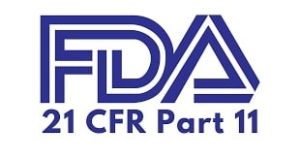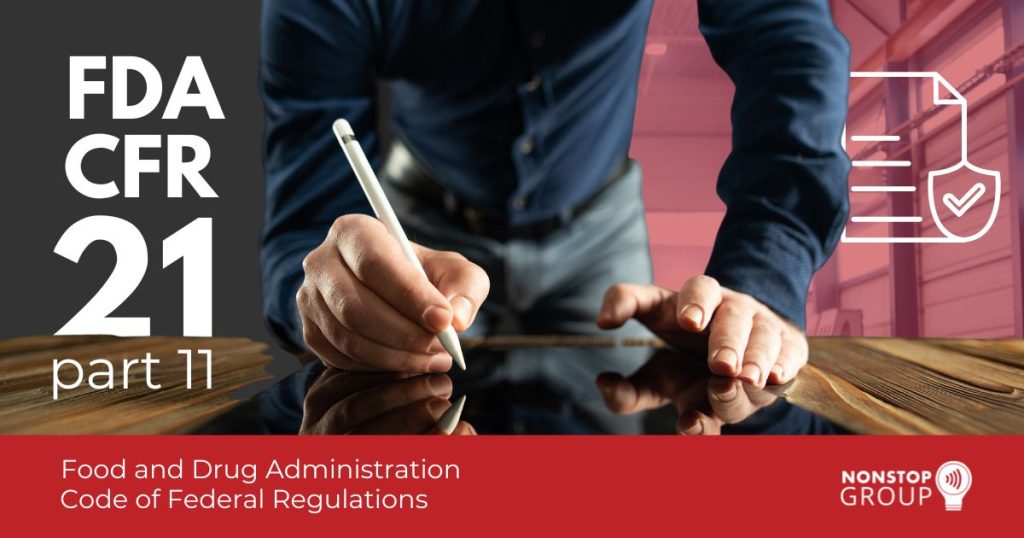6 Min Read
What is FDA CFR 21 Part 11?
In the world of pharmaceuticals, medical devices, and healthcare, maintaining data integrity and security is of utmost importance. To ensure the reliability, authenticity, and accessibility of electronic records and signatures, the Food and Drug Administration (FDA) of the U.S. introduced 21 Code of Federal Regulations (CFR) Part 11, commonly known as FDA CFR 21 Part 11. FDA regulations set the guidelines for electronic records and signatures in industries regulated by the FDA.

Comprehensive Overview
CFR 21 Part 11 is a set of regulations established by the FDA in 1997, specifically targeting electronic records and electronic signatures used in FDA-regulated industries. The regulation aims to ensure the authenticity, integrity, and reliability of an electronic record and electronic signature, thereby replacing the traditional handwritten signatures and paper records.
Purpose
21 CFR Part 11 was developed to provide regulatory guidelines for electronic records and signatures used in various stages of the pharmaceutical and life sciences industries, such as clinical trials, manufacturing, laboratory research, and product registration.
It sets forth the criteria for ensuring the authenticity, integrity, and reliability of electronic records and signatures, aiming to create a framework that promotes trust, compliance, and effective use of technology with the help of a computer system.
Scope
CFR 21 Part 11 is applicable to various FDA-regulated industries, including pharmaceuticals, biotechnology, medical devices, clinical trials, food and beverage, cosmetics, and more. Any organization or entity involved in these industries that creates, modifies, maintains, or transmits electronic records or uses electronic signatures falls under the purview of this regulation.
Different Parts of CFR 21 Part 11
It is crucial to understand distinct identification components that comprise the CFR 21 Part 11 framework. The different parts of CFR 21 Part 11 can be categorized as Subpart A (General Provisions), Subpart B (Electronic Records), and Subpart C (Electronic Signatures)
Subpart A | General Provisions
Subpart A lays the foundation under which an FDA-regulated agency considers electronic records & signatures and handwritten signatures executed to electronic records to be trustworthy and valid.

This section outlines the controls necessary to ensure the authenticity, integrity, and security of electronic signatures. It highlights requirements for unique identification codes, secure password management, and periodic reviews of signature system performance.
Subpart B | Electronic Records
Subpart B of CFR 21 Part 11 focuses on electronic records and their management within regulated industries. It provides guidelines for the creation, modification, and maintenance of electronic records to ensure data integrity and reliability. Key features of Subpart B include validation to demonstrate that electronic systems are capable of producing accurate and reliable records, procedures to protect electronic records from unauthorized access, alteration, or destruction, and flexibility in transitioning to compliant electronic record systems.
Subpart C | Electronic Signatures
Subpart C of CFR 21 Part 11 focuses on electronic signatures, which serve as the digital equivalent of handwritten signatures. It outlines the requirements and controls for the use of electronic signatures to ensure their authenticity and reliability. Key elements of Subpart C include necessary attributes that an electronic signature must include, its association with the corresponding electronic record, and highlighting the need to maintain appropriate documentation such as policies, procedures, and training records. When a series of signings are executed, the first signing shall be executed using all such electronic signature components; subsequent signings shall be executed using at least one electronic signature component.
Key Requirements of FDA CFR 21 Part 11
- Data Integrity: One of the fundamental requirements of FDA CFR 21 Part 11 is to ensure the integrity of electronic records. This entails implementing measures to prevent unauthorized access, modification, or deletion of data. Organizations must maintain accurate and reliable electronic records throughout their lifecycle, ensuring that data remains complete and unaltered.
- Data Retrieval: CFR 21 Part 11 mandates that electronic records be easily retrievable and readily available for review and inspection by regulatory authorities. Organizations must establish efficient data retrieval processes, ensuring that electronic records can be accessed in a timely manner without compromising data integrity.
- Validation: Validation requires organizations to demonstrate that their electronic systems and processes are accurate, reliable, and perform their intended functions consistently. This involves conducting thorough testing, documenting validation activities, and ensuring that systems are properly maintained and calibrated to avoid data inaccuracies and errors.
- Audit Trails: To provide a comprehensive trail of data activities, CFR 21 Part 11 necessitates the implementation of audit trails for electronic records. These audit trails must capture and retain information on any changes made to the data, including the identity of the user, date, time, and the nature of the modification. This facilitates effective data monitoring and regulatory inspections.
- Operational Controls: CFR 21 Part 11 requires organizations to establish operational controls to manage electronic records effectively. This includes implementing procedures for record creation, modification, review, approval, and disposal. Operational controls on computerized systems ensure that electronic records are managed in a controlled and consistent manner, minimizing the risk of data discrepancies and loss.
- Security Controls: Maintaining data security is paramount under FDA CFR 21 Part 11. Organizations must establish robust security and other appropriate controls to protect electronic records from unauthorized access or manipulation. This involves implementing user authentication mechanisms, data encryption, role-based access controls, and physical safeguards to safeguard sensitive information.

- Electronic Signatures: CFR 21 Part 11 allows the use of electronic signatures as legally binding equivalents to traditional handwritten signatures. To be compliant, electronic signatures must be unique to the individual, verifiable, and linked to their respective electronic records.
Smarter Asset Tracking With NFC Tags
Learn more about how NonStop Suite's NFC Asset Tracking Solution can help your Enterprise streamline operations to new heights.
Get A Free Product Tour
Benefits of Compliance with FDA CFR 21 Part 11
21 CFR Part 11 compliance offers numerous benefits to FDA-regulated industries in enhancing validation procedures, exercising enforcement discretion, and ensuring that only authorized individuals have access to an individual’s electronic signature. It ensures that any attempt made to access the system in an unauthorized manner is denied.
- Confidentiality, Integrity, and Accessibility of Data: FDA CFR 21 Part 11 enhances data security by establishing stringent controls and measures for electronic records and signatures. Through encryption, access controls, and audit trails, FDA-regulated industries can protect sensitive data from unauthorized system access.
- Digital Environments: Compliance with 21 CFR Part 11 encourages organizations to transition from paper records to electronic records & signatures. This shift towards paperless environments streamlines data management processes, reduces reliance on physical documentation, and minimizes the chance of errors associated with manual data handling.
- Quick Exchange of Information: Electronic records facilitated by CFR 21 Part 11 enable seamless and instant information exchange across departments and locations. This accelerates accurate and ready retrieval of data, leading to improved operational efficiency and faster response times.
- Reduced Costs and Storage: The adoption of electronic records results in substantial cost savings by eliminating the need for physical storage space. By going paperless and storing data on computer systems, organizations can reduce physical storage requirements and associated expenses, contributing to significant long-term cost savings.
- Reduced Errors: 21 CFR Part 11’s emphasis on data validation and system controls helps minimize errors and discrepancies in electronic records. Data stored in electronic form(s) and time-stamped audit trails provide a transparent view of any changes made to records, allowing for swift identification and correction of errors.
Challenges and Common Pitfalls in FDA CFR 21 Part 11 Compliance
Hospitals and other FDA-regulated industries can face the following challenges and pitfalls related to non-compliance with CFR 21 Part 11 regulations.
- Interpretation and Implementation Complexity: Sometimes, adhering to FDA regulations can be complex and subject to varying interpretations. Different organizations may struggle to understand the precise steps needed to achieve compliance, leading to inconsistencies in implementation. As a result, some companies may inadvertently overlook critical aspects, risking non-compliance and potential penalties.
- Cost of Compliance: Complying with 21 CFR Part 11 requires significant investments in electronic technology, infrastructure, and personnel training. Implementing operational system checks with the necessary security features, validation processes, and audit trail functionalities can be financially demanding, particularly for smaller organizations with limited resources.
- Legacy Systems Integration: For organizations relying on older, legacy systems, transitioning to automated workflows and compliant electronic record-keeping systems can pose challenges. These legacy systems might lack the necessary functionalities, requiring temporary or permanent replacements.
- Security and Data Breach Concerns: While 21 CFR Part 11 emphasizes data security, the increasing sophistication of cyber threats presents a constant challenge. Organizations must remain vigilant in safeguarding electronic records from potential data breaches or cyberattacks for consistent intended performance.
- Vendor and Third-Party Compliance: Many organizations rely on a software vendor or a third-party service provider to manage their electronic systems and records. Ensuring that these external partners also comply with 21 CFR Part 11 can be challenging, as it requires thorough audits, agreements, and ongoing oversight to maintain regulatory adherence.
- Training and Employee Awareness: Compliance with FDA CFR 21 Part 11 necessitates thorough training for employees who handle computer-generated records and signatures. Ensuring that all staff members are aware of the regulation’s requirements can be time-consuming and resource-intensive.
Strategies for Achieving FDA CFR 21 Part 11 Compliance
Companies can consider the following tips and strategies for achieving FDA CFR 21 Part 11 compliance:
- Assess the Requirements and Needs of Your Company: Before embarking on the journey towards compliance, conduct a comprehensive assessment of the agency regulations, operations, processes, and electronic systems.
Understand the requirements of FDA CFR 21 Part 11 that apply to your organization and identify potential gaps in your current practices. This assessment will form the foundation for developing a tailored compliance strategy. - Establish Clear Audit Trails: Audit trails provide a detailed record of all data activities, including changes made to electronic data and signatures. Ensure that your electronic systems have the capability to generate and retain accurate and secure audit trail information, allowing for effective data monitoring and traceability.
- Follow Part 11 Guidance for Data Security and Password Protection: Establish strict controls and controlled system access to safeguard electronic records and prevent unauthorized access. Implement secure password protection mechanisms, encryption protocols, and user authentication procedures in electronic format. Update or delete electronic records that are outdated, and regularly review security measures to address emerging threats and vulnerabilities.
- Follow 21 CFR Part 11 Requirements on Records and Electronic Signatures: Adhere to the specific requirements outlined in 21 CFR Part 11 regarding electronic records and signatures. Ensure that your electronic systems support compliant record creation, modification, maintenance, and disposal processes. Implement electronic signatures that are unique, verifiable, and linked to corresponding electronic records to establish the legal equivalency of handwritten signatures.
Final Words
FDA 21 CFR Part 11 is a critical regulatory framework that plays a pivotal role in the digital transformation of FDA-regulated industries. By addressing the challenges associated with electronic records and signatures, this comprehensive regulation ensures data integrity, security, and reliability while fostering trust between stakeholders and regulatory authorities. It aims to prevent unauthorized access, data tampering, and the distribution of counterfeit or fraudulent products, ultimately safeguarding public health and maintaining the credibility of pharmaceuticals, biotechnology, medical devices, clinical trials, food and beverage, cosmetics, and other FDA-regulated industries. If you are looking to streamline 21 CFR Part 11 compliance for your organization, consult The NonStop Group today.


